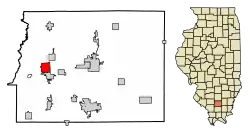North City, Illinois
North City is a village in Franklin County, Illinois, United States. As of the 2010 census the population was 608.[3] Mayor is Curtis Overton.
North City, Illinois
Coello | |
|---|---|
 Location of North City in Franklin County, Illinois. | |
.svg.png.webp) Location of Illinois in the United States | |
| Coordinates: 37°59′35″N 89°3′56″W | |
| Country | United States |
| State | Illinois |
| County | Franklin |
| Township | Tyrone |
| Area | |
| • Total | 2.23 sq mi (5.77 km2) |
| • Land | 2.17 sq mi (5.62 km2) |
| • Water | 0.06 sq mi (0.15 km2) |
| Elevation | 455 ft (139 m) |
| Population (2010) | |
| • Total | 608 |
| • Estimate (2019)[2] | 569 |
| • Density | 262.09/sq mi (101.20/km2) |
| Time zone | UTC-6 (CST) |
| • Summer (DST) | UTC-5 (CDT) |
| ZIP Code(s) | 62825 |
| Area code(s) | 618 |
| FIPS code | 17-53585 |
| Wikimedia Commons | North City, Illinois |
Geography
North City is located in western Franklin County at 37°59′35″N 89°3′56″W (37.993129, -89.065547).[4] It is bordered to the south by the city of Christopher. Illinois Route 148 passes through the eastern side of the village, leading north 2.5 miles (4.0 km) to Valier, north 7 miles (11 km) to Sesser, and south through Christopher 7 miles (11 km) to Zeigler. Illinois Route 14 runs just south of North City, leading east 7.5 miles (12.1 km) to Benton, the Franklin County seat, and west 12 miles (19 km) to Du Quoin.
According to the 2010 census, North City has a total area of 2.236 square miles (5.79 km2), of which 2.18 square miles (5.65 km2) (or 97.5%) is land and 0.056 square miles (0.15 km2) (or 2.5%) is water.[5]
North City is also known as "Coello".[6]
Demographics
| Historical population | |||
|---|---|---|---|
| Census | Pop. | %± | |
| 1920 | 1,362 | — | |
| 1930 | 900 | −33.9% | |
| 1940 | 601 | −33.2% | |
| 1950 | 513 | −14.6% | |
| 1960 | 362 | −29.4% | |
| 1970 | 356 | −1.7% | |
| 1980 | 404 | 13.5% | |
| 1990 | 538 | 33.2% | |
| 2000 | 630 | 17.1% | |
| 2010 | 608 | −3.5% | |
| 2019 (est.) | 569 | [2] | −6.4% |
| U.S. Decennial Census[7] | |||
As of the census[8] of 2000, there were 630 people, 259 households, and 178 families residing in the village. The population density was 287.3 people per square mile (111.1/km2). There were 277 housing units at an average density of 126.3 per square mile (48.8/km2). The racial makeup of the village was 97.14% White, 0.32% African American, 0.32% Asian, 1.59% from other races, and 0.63% from two or more races. Hispanic or Latino of any race were 1.90% of the population.
There were 259 households, out of which 26.6% had children under the age of 18 living with them, 59.1% were married couples living together, 6.9% had a female householder with no husband present, and 30.9% were non-families. 27.4% of all households were made up of individuals, and 12.4% had someone living alone who was 65 years of age or older. The average household size was 2.43 and the average family size was 2.97.
In the village, the population was spread out, with 22.9% under the age of 18, 8.7% from 18 to 24, 25.7% from 25 to 44, 25.1% from 45 to 64, and 17.6% who were 65 years of age or older. The median age was 41 years. For every 100 females, there were 104.5 males. For every 100 females age 18 and over, there were 102.5 males.
The median income for a household in the village was $27,381, and the median income for a family was $36,250. Males had a median income of $29,375 versus $20,714 for females. The per capita income for the village was $13,360. About 14.1% of families and 19.6% of the population were below the poverty line, including 29.5% of those under age 18 and 20.0% of those age 65 or over.
References
- "2019 U.S. Gazetteer Files". United States Census Bureau. Retrieved July 14, 2020.
- "Population and Housing Unit Estimates". United States Census Bureau. May 24, 2020. Retrieved May 27, 2020.
- "Geographic Identifiers: 2010 Census Summary File 1 (G001), North City village, Illinois". American FactFinder. U.S. Census Bureau. Archived from the original on February 13, 2020. Retrieved May 4, 2016.
- "US Gazetteer files: 2010, 2000, and 1990". United States Census Bureau. 2011-02-12. Retrieved 2011-04-23.
- "G001 - Geographic Identifiers - 2010 Census Summary File 1". United States Census Bureau. Archived from the original on 2020-02-13. Retrieved 2015-12-25.
- Callary, Edward (2009). Place Names of Illinois. University of Illinois Press. p. 73. ISBN 978-0-252-03356-8.
- "Census of Population and Housing". Census.gov. Retrieved June 4, 2015.
- "U.S. Census website". United States Census Bureau. Retrieved 2008-01-31.